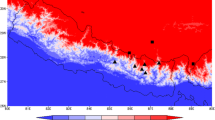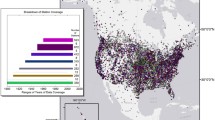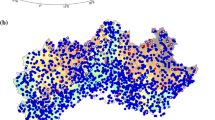Abstract
Changes in the frequency or intensity of extreme precipitation events would have profound impacts on both human society and the natural environment. In this paper, we present the results of a comprehensive analysis of the spatiotemporal changes of extreme precipitation in the western United States. The analyses explore the spatial characterization of the El Nino-Southern Oscillation (ENSO)-extreme precipitation response pattern and identify the multi-scale temporal variability in precipitation extremes in the western United States. Results indicate: (1) Extreme precipitation expressed in indices such as seasonal count of days when precipitation is large than 10 mm (R10), seasonal maximum 5-day precipitation (R5D), maximum length of dry spell (CDD), and seasonal total precipitation exceeding 95 percentile (R95) have a dipolar pattern and a transition zone which separates the west into two main dipolar centers regarded as Pacific Northwest and Desert Southwest. The simple precipitation intensity index (SDII) has little correlation with large scale natural oscillations over most of the west. (2) The spatial distributions of annual trend of R10, R5D, SDII, and R95 have seasonal variability in southern California and Lower Colorado River Basin. (3) There are consistent multi-year bands ranging from 2 to 20 years in the R10, R5D, CDD, and R95 winter time series which may be caused by the inter-decadal or multi-decadal modulation of ENSO effects on precipitation extremes. The results can provide beneficial reference to the prediction of precipitation extremes in the west.







Similar content being viewed by others
References
Adamowski J, Adamowski K, Bougadis J (2010) Influence of trend on short duration design storms. Water Resour Manag 24:401–413
Alexander L et al. (2006) Global observed changes in daily climate extremes of temperature and precipitation. J Geophys Res 111
Allen MR, Ingram WJ (2002) Constraints on future changes in climate and the hydrologic cycle. Nature 419:224–232
Brown DP, Comrie AC (2004) A winter precipitation ‘dipole’in the western United States associated with multidecadal ENSO variability. Geophys Res Lett 31:L09203
Cayan DR, Redmond KT, Riddle LG (1999) ENSO and hydrologic extremes in the western United States. J Clim 12:2881–2893
Cressman GP (1959) An operational objective analysis system. Mon Weather Rev 87:367–374
Curtis S (2008) The Atlantic multidecadal oscillation and extreme daily precipitation over the US and Mexico during the hurricane season. Clim Dyn 30:343–351
Darand M, Daneshvar MRM (2014) Regionalization of precipitation regimes in iran using principal component analysis and hierarchical clustering analysis. Environ Process 1:517–532
Easterling DR, Evans J, Groisman PY, Karl T, Kunkel K, Ambenje P (2000) Observed variability and trends in extreme climate events: a brief review. Bulletin of the American Meteorologyical. Society 81:417–426
Enfield DB, Mestas-Nunez AM, Trimble PJ (2001) The Atlantic multidecadal oscillation and its relation to rainfall and river flows in the continental U. S. Geophys Res Lett 28:2077–2080
Frich P, Alexander L, Della-Marta P, Gleason B, Haylock M, Klein Tank A, Peterson T (2002) Observed coherent changes in climatic extremes during the second half of the twentieth century. Clim Res 19:193–212
Gershunov A (1998) ENSO influence on Intraseasonal extreme rainfall and temperature frequencies in the contiguous United States: implications for long-range predictability. J Clim 11:3192–3203
Gershunov A, Barnett TP (1998) ENSO influence on intraseasonal extreme rainfall and temperature frequencies in the contiguous United States: observations and model results. J Clim 11:1575–1586
Groisman PY, Knight RW, Easterling DR, Karl TR, Hegerl GC, Razuvaev VN (2005) Trends in intense precipitation in the climate record. J Clim 18:1326–1350
Groisman PY, Knight RW, Karl TR (2001) Heavy precipitation and high streamflow in the contiguous United States: trends in the twentieth century. Bull Am Meteorol Soc 82:219–246
Houghton, JT (2001) Climate change 2001: the scientific basis vol 881. Cambridge University Press, Cambridge
Jiang P, Gautam MR, Zhu J, Yu Z (2013a) How well do the GCMs/RCMs capture the multi-scale temporal variability of precipitation in the southwestern United States? J Hydrol 479:75–85
Jiang P, Z Y, Gautam MR (2013b) Pacific and Atlantic Ocean influence on the spatiotemporal variability of heavy precipitation in the western United States. Glob Planet Chang 109:38–45
Jiang P, Yu Z, Gautam MR, Yuan F, Acharya K (2016) Changes of storm properties in the United States: observations and multimodel ensemble projections. Glob Planet Chang 142:41–52
Karl TR, Knight RW (1998) Secular trends of precipitation amount, frequency, and intensity in the United States. Bull Am Meteorol Soc 79:231–241
Karl TR, Knight RW, Plummer N (1995) Trends in high-frequency climate variability in the twentieth century. Nature 377:217–220
Karl TR, Riebsame WE (1989) The impact of decadal fluctuations in mean precipitation and temperature on runoff: a sensitivity study over the United States. Clim Chang 15:423–447
Kunkel KE, Andsager K, Easterling DR (1999) Long-term trends in extreme precipitation events over the conterminous United States and Canada. J Clim 12:2515–2527
Kunkel KE, Easterling DR, Redmond K, Hubbard K (2003) Temporal variations of extreme precipitation events in the United States: 1895–2000. Geophys Res Lett 30:1900
Mantua NJ, Hare SR (2002) The Pacific decadal oscillation. J Oceanogr 58:35–44
Meehl GA, Tebaldi C, Teng H, Peterson TC (2007) Current and future US weather extremes and el Niño. Geophys Res Lett 34:L20704
Meehl GA, Zwiers F, Evans J, Knutson T, Mearns L, Whetton P (2000) Trends in extreme weather and climate events: issues related to modeling extremes in projections of future climate change. Bulletin of American Meteorological Society 81:427–436
Min SK, Zhang X, Zwiers FW, Hegerl GC (2011) Human contribution to more-intense precipitation extremes. Nature 470:378–381
Mote PW (2006) Climate-driven variability and trends in mountain snowpack in western North America. J Clim 19:6209–6220
Mote PW, Hamlet AF, Clark MP, Lettenmaier DP (2005) Declining mountain snowpack in western North America. Bull Am Meteorol Soc 86:39–44
Peralta-Hernandez A, Balling R Jr, Barba-Martinez L (2009) Comparative analysis of indices of extreme rainfall events: variations and trends from southern México. Atmósfera 22:219–228
Piechota T, Timilsena J, Tootle G, Hidalgo H (2004) The western US drought: how bad is it. Eos 85:301–304
Redmond KT, Koch RW (1991) Surface climate and streamflow variability in the western United States and their relationship to large-scale circulation indices. Water Resour Res 27:2381–2399
Rodbell DT, Seltzer GO, Anderson DM, Abbott MB, Enfield DB, Newman JH (1999) An ~ 15,000-year record of el Niño-driven alluviation in southwestern Ecuador. Science 283:516–520
Ryu JH, Svoboda MD, Lenters JD, Tadesse T, Knutson CL (2010) Potential extents for ENSO-driven hydrologic drought forecasts in the United States. Clim Chang 101:575–597
Saidi H, Ciampittiello M, Dresti C, Ghiglieri G (2015) Assessment of trends in extreme precipitation events: a case study in piedmont (north-West Italy. Water Resour Manag 29:63–80
Semenov V, Bengtsson L (2002) Secular trends in daily precipitation characteristics: greenhouse gas simulation with a coupled AOGCM. Clim Dyn 19:123–140
Sena JA, De Deus LAB, Freitas MAV, Costa L (2012) Extreme events of droughts and floods in Amazonia: 2005 and 2009. Water Resources Management 26:1665–1676
Shi P et al. (2015) Spatial distribution and temporal trends in precipitation concentration indices for the Southwest China. Water Resour Manag 29:3941–3955
Vasiliades L, Galiatsatou P, Loukas A (2015) Nonstationary frequency analysis of annual maximum rainfall using climate covariates. Water Resour Manag 29:339–358
Vecchi G, Clement A, Soden B (2008) Examining the tropical Pacific’s response to global warming. Eos 89:81–83
Westra S, Sharma A (2006) Dominant modes of interannual variability in Australian rainfall analyzed using wavelets. J Geophys Res 111:D05102
Wise EK (2010) Spatiotemporal variability of the precipitation dipole transition zone in the western United States. Geophys Res Lett 37:L07706
Yang T et al. (2011) Changes of climate extremes in a typical arid zone: observations and multimodel ensemble projections. J Geophys Res 116:D19106
Yilmaz A, Perera B (2015) Spatiotemporal trend analysis of extreme rainfall events in Victoria, Australia. Water Resour Manag 29:4465–4480
Yu Z, Jiang P, Gautam MR, Zhang Y, Acharya K (2015) Changes of seasonal storm properties in California and Nevada from an ensemble of climate projections. Journal of Geophysical Research: Atmospheres 120:2676–2688
Yuan F, Berndtsson R, Uvo CB, Zhang L, Jiang P (2015) Summer precipitation prediction in the source region of the Yellow River using climate indices. Hydrology Research:nh2015062
Zhang X et al. (2007) Detection of human influence on twentieth-century precipitation trends. Nature 448:461–465
Acknowledgments
This research was made possible by the generosity and support of the Sulo and Aileen Maki Endowment to the first author. The authors acknowledge that the views herein are that of the authors only and does not necessary reflect the review of the funding agencies and the organizations they are affiliated to.
Author information
Authors and Affiliations
Corresponding authors
Rights and permissions
About this article
Cite this article
Jiang, P., Yu, Z., Gautam, M.R. et al. The Spatiotemporal Characteristics of Extreme Precipitation Events in the Western United States. Water Resour Manage 30, 4807–4821 (2016). https://doi.org/10.1007/s11269-016-1454-z
Received:
Accepted:
Published:
Issue Date:
DOI: https://doi.org/10.1007/s11269-016-1454-z




